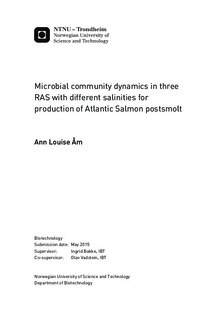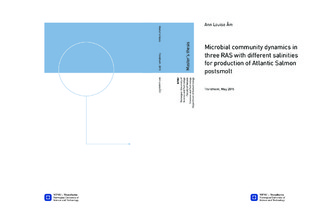| dc.description.abstract | Bacteria in the water interacts with the fish and can affect their health and survival. A stable microbial community in the rearing water can promote a good rearing environment for the fish. The purpose of this study was to examine the microbial community dynamics in three recircu-lating aquaculture systems (RAS) that were run at different salinities. This was performed by comparing the microbial community structure of samples from biofilm carriers, biofilter water and rearing water that were sampled at different dates over a period of 5 months from the three RAS that run salinities at 12 , 22 and 32 .
Total DNA were extracted from the samples and PCR (polymerase chain reaction) was used to amplify the variable region 3 of the highly conserved and universal bacterial gene 16S rRNA. The DGGE (denaturing gradient gel electrophoresis) method was used to analyze the resulting PCR products, and to characterize the microbial communities. The results were ana-lyzed statistically to examine variations between communities of samples from the different systems and dates.
It was found that the different salinities gave different microbial communities, which indicate that the salinity had an impact on the microbial communities in RAS. Both the biofilter and rearing tank water communities showed significant differences when compared between sys-tems and within systems at different dates. The results indicate that the microbial communities of the biofilm carriers were less affected by the salinity than the water communities. The mi-crobial communities in biofilm carriers developed to become more similar to the communities of the biofilm carriers from the other RAS over time, even though they were sampled from different salinities. The biofilm communities were also found to be more stable than water communities over time. | |

